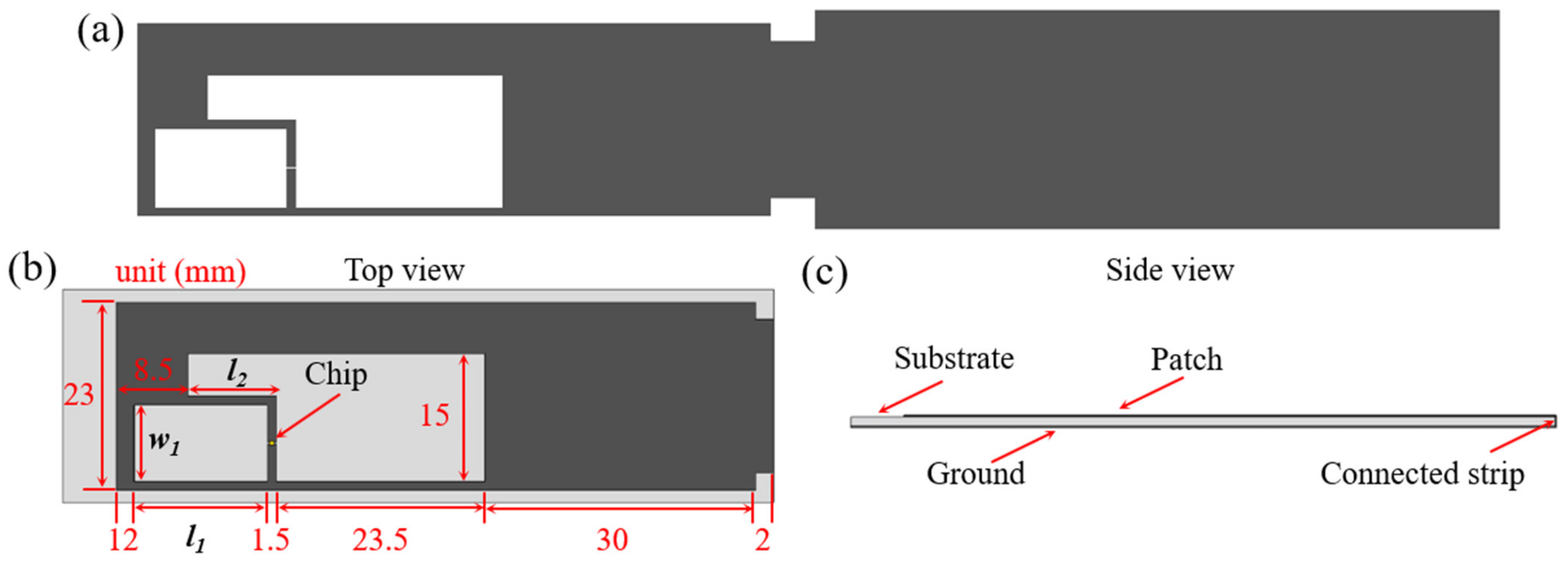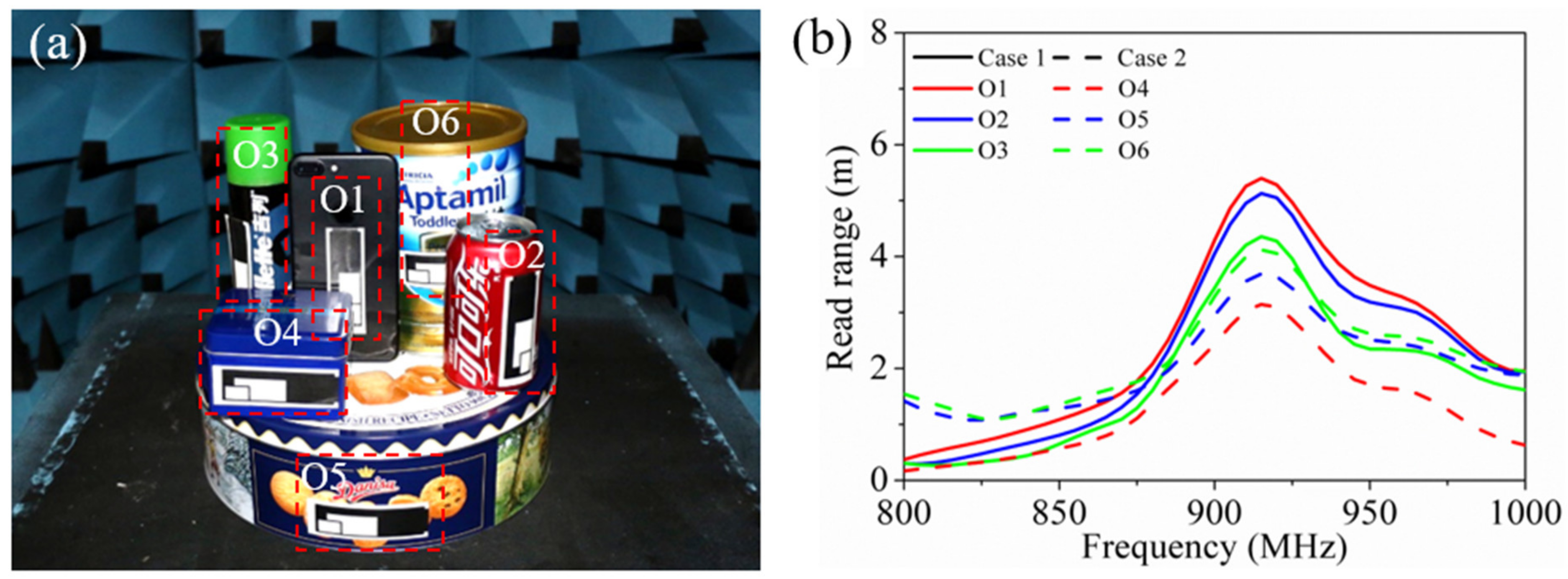Flexible Anti-Metal RFID Tag Antenna Based on High-Conductivity Graphene Assembly Film
Abstract
:1. Introduction
2. Material Preparation and Characterization
3. HCGAF Antenna Design and Measurements
3.1. Complex Impedance Conjugate Matching Theory
3.2. Design of HCGAF Antenna
3.3. Performance Measurements of HCGAF Antenna
4. Tag Measurements and Conformal Applications
4.1. Tag Measurements on Flat Copper Plates
4.2. Tag Measurements on Curved Copper Plates
4.3. Tag Conformal Application on Daily Metallic Objects
5. Conclusions
Supplementary Materials
Author Contributions
Funding
Informed Consent Statement
Data Availability Statement
Conflicts of Interest
References
- Landt, J. The history of RFID. IEEE Potentials 2005, 24, 8–11. [Google Scholar] [CrossRef]
- Juels, A. RFID security and privacy: A research survey. IEEE J. Select. Areas Commun. 2006, 24, 381–394. [Google Scholar] [CrossRef]
- Want, R. An introduction to RFID technology. IEEE Pervasive Comput. 2006, 5, 25–33. [Google Scholar] [CrossRef]
- Zhang, J.; Tian, G.; Marindra, A.; Sunny, A.; Zhao, A. A review of passive RFID tag antenna-based sensors and systems for structural health monitoring applications. Sensors 2017, 17, 265. [Google Scholar] [CrossRef]
- Finkenzeller, K. RFID Handbook: Fundamentals and Applications in Contactless Smart Cards, Radio Frequency Identification and Near-field Communication; John Wiley & Sons: Hoboken, NJ, USA, 2010. [Google Scholar]
- Rao, K.V.S.; Nikitin, P.V.; Lam, S.F. Antenna design for UHF RFID tags: A review and a practical application. IEEE Trans. Antennas Propag. 2005, 53, 3870–3876. [Google Scholar] [CrossRef]
- Occhiuzzi, C.; Caizzone, S.; Marrocco, G. Passive UHF RFID antennas for sensing applications: Principles, methods, and classifcations. IEEE Antennas Propag. Mag. 2013, 55, 14–34. [Google Scholar] [CrossRef] [Green Version]
- Björninen, T.; Sydänheimo, L.; Ukkonen, L.; Rahmat-Samii, Y. Advances in antenna designs for UHF RFID tags mountable on conductive items. IEEE Antennas Propag. Mag. 2016, 56, 79–103. [Google Scholar] [CrossRef]
- Ukkonen, L.; Sydanheimo, L.; Kivikoski, M. Effects of metallic plate size on the performance of microstrip patch-type tag antennas for passive RFID. IEEE Antennas Wireless Propag. Lett. 2005, 4, 410–413. [Google Scholar] [CrossRef]
- Gao, B.; Yuen, M.M.F. Passive UHF RFID packaging with electromagnetic band gap (EBG) material for metallic objects tracking. IEEE Trans. Compon. Packaging Manuf. Technol. 2011, 1, 1140–1146. [Google Scholar] [CrossRef]
- Kim, D.; Yeo, J. Dual-band long-range passive RFID tag antenna using an AMC ground plane. IEEE Trans. Antennas Propag. 2012, 60, 2620–2626. [Google Scholar] [CrossRef]
- Park, I.; Kim, D. Artificial magnetic conductor loaded long-range passive RFID tag antenna mountable on metallic objects. Electron. Lett. 2014, 50, 335–336. [Google Scholar] [CrossRef]
- Hirvonen, M.; Pursula, P.; Jaakkola, K.; Laukkanen, K. Planar inverted-F antenna for radio frequency identification. Electron. Lett. 2004, 40, 848–850. [Google Scholar] [CrossRef]
- Kwon, H.; Lee, B. Compact slotted planar inverted-F RFID tag mountable on metallic objects. Electron. Lett. 2005, 41, 1308–1310. [Google Scholar] [CrossRef]
- Kim, S.J.; Yu, B.; Chung, Y.S.; Harackiewicz, F.J.; Lee, B. Patch-type radio frequency identification tag antenna mountable on metallic platforms. Microw. Opt. Technol. Lett. 2006, 48, 2446–2448. [Google Scholar] [CrossRef]
- Mo, L.; Zhang, H.; Zhou, H. Broadband UHF RFID tag antenna with a pair of U slots mountable on metallic objects. Electron. Lett. 2008, 44, 1173–1174. [Google Scholar] [CrossRef]
- Kim, J.S.; Choi, W.; Choi, G.Y. UHF RFID tag antenna using two PIFAs embedded in metallic objects. Electron. Lett. 2008, 44, 1181–1182. [Google Scholar] [CrossRef]
- Zhang, Y.J.; Wang, D.; Tong, M.S. An adjustable quarter-wavelength meandered dipole antenna with slotted ground for metallically and airily mounted RFID tag. IEEE Trans. Antennas Propag. 2017, 65, 2890–2898. [Google Scholar] [CrossRef]
- Polivka, M.; Svanda, M. Stepped impedance coupled-patches tag antenna for platform-tolerant UHF RFID applications. IEEE Trans. Antennas Propag. 2015, 63, 3791–3797. [Google Scholar] [CrossRef]
- Ria, A.; Michel, A.; Singh, R.K.; Franchina, V.; Bruschi, P.; Nepa, P. Performance analysis of a compact UHF RFID ceramic tag in high-temperature environments. IEEE J. Radio Freq. Identif. 2020, 4, 461–467. [Google Scholar] [CrossRef]
- Son, H.W.; Jeon, H.G.; Cho, J.H. Flexible wideband UHF RFID tag antenna for curved metal surfaces. Electron. Lett. 2012, 48, 749–750. [Google Scholar] [CrossRef]
- Deng, Y.; Du, G.H.; Tang, T. Dual-band metal skin UHF RFID tag antenna. Electron. Lett. 2013, 49, 858–860. [Google Scholar]
- Bong, F.L.; Lim, E.H.; Lo, F.L. Miniaturized dipolar patch antenna with narrow meandered slot line for UHF tag. IEEE Trans. Antennas Propag. 2017, 65, 4435–4442. [Google Scholar] [CrossRef]
- Babar, A.A.; Bjorninen, T.; Bhagavati, V.A.; Sydanheimo, L.; Kallio, P.; Ukkonen, L. Small and flexible metal mountable passive UHF RFID tag on high-dielectric polymer-ceramic composite substrate. IEEE Antennas Wireless Propag. Lett. 2012, 11, 1319–1322. [Google Scholar] [CrossRef]
- Higginbotham, S. The internet of trash [Internet of Everything]. IEEE Spectr. 2018, 55, 17. [Google Scholar] [CrossRef]
- Forti, V.; Balde, C.P.; Kuehr, R.; Bel, G. The Global E-Waste Monitor 2020: Quantities, Flows and the Circular Economy Potential; International Solid Waste Association (ISWA): Rotterdam, The Netherlands; United Nations University (UNU)/United Nations Institute for Training and Research (UNITAR)—Co-hosted SCYCLE Programme: Bonn, Germany; International Telecommunication Union (ITU): Geneva, Switzerland, 2020. [Google Scholar]
- Yang, L.; Zhang, R.; Staiculescu, D.; Wong, C.P.; Tentzeris, M.M. A novel conformal RFID-enabled module utilizing inkjet-printed antennas and carbon nanotubes for gas-detection applications. IEEE Antennas Wireless Propag. Lett. 2009, 8, 653–656. [Google Scholar] [CrossRef] [Green Version]
- Amram Bengio, E.; Senic, D.; Taylor, L.W.; Headrick, R.J.; King, M.; Chen, P.; Little, C.A.; Ladbury, J.; Long, C.J.; Holloway, C.L.; et al. Carbon nanotube thin film patch antennas for wireless communications. Appl. Phys. Lett. 2019, 114, 203102. [Google Scholar] [CrossRef]
- Akbari, M.; Khan, M.W.A.; Hasani, M.; Bjorninen, T.; Sydanheimo, L.; Ukkonen, L. Fabrication and characterization of graphene antenna for low-cost and environmentally friendly RFID tags. IEEE Antennas Wireless Propag. Lett. 2015, 15, 1569–1572. [Google Scholar] [CrossRef]
- Huang, X.; Leng, T.; Zhang, X.; Chen, J.C.; Chang, K.H.; Geim, A.K.; Novoselov, K.S.; Hu, Z. Binder-free highly conductive graphene laminate for low cost printed radio frequency applications. Appl. Phys. Lett. 2015, 106, 203105. [Google Scholar] [CrossRef]
- Leng, T.; Huang, X.; Chang, K.; Chen, J.; Abdalla, M.A.; Hu, Z. Graphene nanoflakes printed flexible meandered-line dipole antenna on paper substrate for low-cost RFID and sensing applications. IEEE Antennas Wireless Propag. Lett. 2016, 15, 1565–1568. [Google Scholar] [CrossRef]
- Kopyt, P.; Salski, B.; Olszewska-Placha, M.; Janczak, D.; Sloma, M.; Kurkus, T.; Jakubowska, M.; Gwarek, W. Graphene-based dipole antenna for a UHF RFID tag. IEEE Trans. Antennas Propag. 2016, 64, 2862–2868. [Google Scholar] [CrossRef]
- Pan, K.; Fan, Y.; Leng, T.; Li, J.; Xin, Z.; Zhang, J.; Hao, L.; Gallop, J.; Novoselov, K.S.; Hu, Z. Sustainable production of highly conductive multilayer graphene ink for wireless connectivity and IoT applications. Nat. Commun. 2018, 9, 5197. [Google Scholar] [CrossRef]
- Scidà, A.; Haque, S.; Treossi, E.; Robinson, A.; Smerzi, S.; Ravesi, S.; Borini, S.; Palermo, V. Application of graphene-based flexible antennas in consumer electronic devices. Mater. Today 2018, 21, 223–230. [Google Scholar] [CrossRef]
- Zhou, W.; Liu, C.; Song, R.; Zeng, X.; Li, B.W.; Xia, W.; Zhang, J.; Huang, G.L.; Wu, Z.P.; He, D. Flexible radiofrequency filters based on highly conductive graphene assembly films. Appl. Phys. Lett. 2019, 114, 113503. [Google Scholar] [CrossRef]
- Zhang, H.; Wen, P.; Li, P.; Wang, Z.; Wang, S.; Zhao, X.; Xiao, Y.; Shen, J.; He, D.; Chen, W. Enhanced output performance of flexible piezoelectric energy harvester by using auxetic graphene films as electrodes. Appl. Phys. Lett. 2020, 117, 103901. [Google Scholar] [CrossRef]
- Wang, Z.; Li, P.; Song, R.; Qian, W.; Zhou, H.; Wang, Q.; Wang, Y.; Zeng, X.; Ren, L.; Yan, S.; et al. High conductive graphene assembled films with porous micro-structure for freestanding and ultra-low power strain sensors. Sci. Bull. 2020, 65, 1363–1370. [Google Scholar] [CrossRef]
- Peng, L.; Xu, Z.; Liu, Z.; Guo, Y.; Li, P.; Gao, C. Ultrahigh thermal conductive yet superflexible graphene films. Adv. Mater. 2017, 29, 1700589. [Google Scholar] [CrossRef]
- De Vita, G.; Iannaccon, G. Design criteria for the RF section of UHF and microwave passive RFID transponders. IEEE Trans. Microw. Theory. Tech. 2005, 53, 2978–2990. [Google Scholar] [CrossRef]
- Impinj Datasheet Monza R6. 2020. Available online: https://support.impinj.com/hc/en-us/articles/202765328-Monza-R6-Product-Datasheet (accessed on 19 February 2021).
- Moh, C.W.; Lim, E.H.; Bong, F.L.; Chung, B.K. Miniature coplanar-fed folded patch for metal mountable UHF RFID tag. IEEE Trans. Antennas Propag. 2018, 66, 2245–2253. [Google Scholar] [CrossRef]
- Qing, X.; Goh, C.K.; Chen, Z.N. Impedance characterization of RFID tag antennas and application in tag co-design. IEEE Trans. Microw. Theory Tech. 2009, 57, 1268–1274. [Google Scholar] [CrossRef]















Publisher’s Note: MDPI stays neutral with regard to jurisdictional claims in published maps and institutional affiliations. |
© 2021 by the authors. Licensee MDPI, Basel, Switzerland. This article is an open access article distributed under the terms and conditions of the Creative Commons Attribution (CC BY) license (http://creativecommons.org/licenses/by/4.0/).
Share and Cite
Zhang, B.; Zhang, C.; Wang, Y.; Wang, Z.; Liu, C.; He, D.; Wu, Z.P. Flexible Anti-Metal RFID Tag Antenna Based on High-Conductivity Graphene Assembly Film. Sensors 2021, 21, 1513. https://doi.org/10.3390/s21041513
Zhang B, Zhang C, Wang Y, Wang Z, Liu C, He D, Wu ZP. Flexible Anti-Metal RFID Tag Antenna Based on High-Conductivity Graphene Assembly Film. Sensors. 2021; 21(4):1513. https://doi.org/10.3390/s21041513
Chicago/Turabian StyleZhang, Bohan, Cheng Zhang, Yuchao Wang, Zhe Wang, Chengguo Liu, Daping He, and Zhi P. Wu. 2021. "Flexible Anti-Metal RFID Tag Antenna Based on High-Conductivity Graphene Assembly Film" Sensors 21, no. 4: 1513. https://doi.org/10.3390/s21041513
APA StyleZhang, B., Zhang, C., Wang, Y., Wang, Z., Liu, C., He, D., & Wu, Z. P. (2021). Flexible Anti-Metal RFID Tag Antenna Based on High-Conductivity Graphene Assembly Film. Sensors, 21(4), 1513. https://doi.org/10.3390/s21041513










